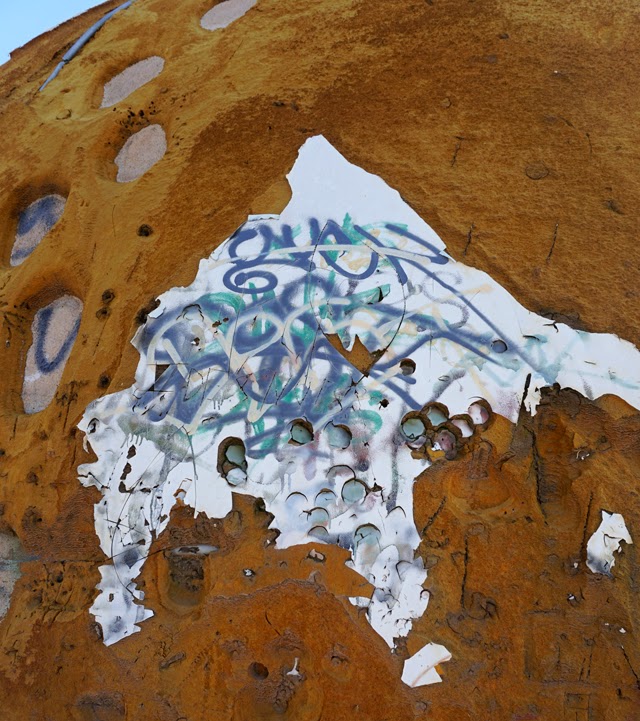Skip to main content
Domes / KG Guest Essay
In 1879, when the tracks to the Southern Pacific Railroad ran out, five overheated workers from Yuma dug their heels in the sand—and the community of Terminus, Arizona, was born. The three buildings they raised in the aridity of the high Sonoran desert were truly the “end of the line.” When the summer heat wave ended, the tracks from Terminus resumed to Tucson, and the micro-village grew into a small town. In a nod to local prehistory for the nearby Hohokam ruins—or perhaps to avoid christening the place as a future ghost town—railroad executives redubbed Terminus as “Casa Grande.”
The town boomed as a railhead to mining prospects, but fires levelled the town center to cinders twice within a decade. When mining slowed in the 1890s, agriculture took over, and Casa Grande settled into itself, with a current population of about 48,000. True to its railway roots, Casa Grande is alternately referred to as the “crossroads” and “heart” of Arizona: smack at the intersection of the I-10 and I-8 interstates, and almost dead center between Phoenix and Tucson.
This prior history is typical. But at the southern edge of town, from an off-ramp on the I-8 near a Wal-Mart Distribution center, strange structures waver in the distance. And driving closer doesn’t help them come into any greater focus. Stuck in the scrabbly sand, on a small plot hugged by a larger landscape that is as sparse as Terminus must have seemed in 1800-hundred-whatever, a small UFO fleet and a space centipede appear to have crash landed on earth. All of this alien strangeness is not an event that flew under the radar of the NSA—“The Domes” are architectural ghosts—physical remainders of 1980s computing manufacturing gone wrong.

InnerConn Technology was incorporated in 1968 in Mountain View, California. The company was active at a feverish time in computing history, with hot competition on the mini and personal computing market. Innercon, for their part, was one of many companies that produced circuit boards to fuel Silicon Valley’s dreams. In 1982, the owner, Patricia Zebb, decided to transfer headquarters to Arizona and build a new factory—this is the true origin of The Domes.

Innerconn commissioned four structures to be built using Thermoshell construction techniques over the course of six short weeks. Huge balloon-like bladders created the forms of the buildings, supported internally by steel trusses. Several inches of polyurethane foam were poured over the top, followed by several more of concrete. When the foam and concrete had hardened, the balloon and truss systems were removed, leaving behind an open space free of support columns—perfect for manufacturing assembly lines. The concrete and foam were passive insulation against the Arizona sun. There are signs of foundations laid for buildings that were never built because Innerconn’s techno-optimism was squashed when they went bankrupt in 1983. The company built an organic cathedral to computing assembly in the desert, but sadly, the company went bust before anyone had the chance to move in.

The Domes were doomed to never be repurposed. Exposed to the elements, orange polyurethane foam now pokes through the crumbling concrete. They are tempting (but illegal without permission) to explore. I’ve heard that the acoustics created by their shape is a perfect match for their exterior otherworldliness. The site amplifies and feeds back upon itself—a kicked pebble sounds like a gunshot across a canyon, the reverb at the center of the largest UFO dome makes it sound like you are underwater.

Rumors of their use collide into a freeway pileup: as rave caves, human trafficking drop-offs, supernatural hotspots… and lairs for satanic rituals. The graffitied interiors and beer cans make it more likely that “bored teenage hangout” is the typical day-to-day use for The Domes. But who knows what that eerie tapping and humming was that Esoteric Survey and I heard coming through his car’s air vents while we were parked roadside at The Domes. Might have been a ghost. Or the sound of a computer factory at the edge of the end of the world thrumming into action.
I'd like to thank my good friend Kristen Gallerneaux for writing the text for this post. Along with being a great road companion, she is the Curator of Communication and Information Technology at The Henry Ford Museum. She is obviously way overqualified to be wasting her time writing anything for this blog, but I'm honored that she did.








